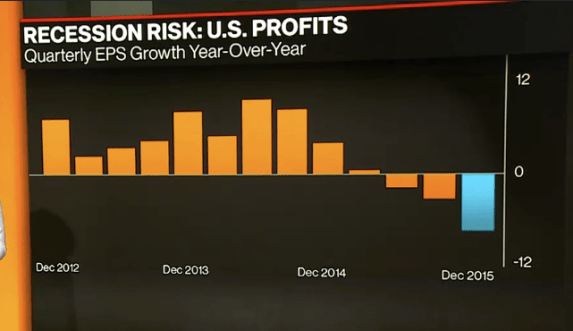Ever since the Federal Reserve raised interest rates in December, Peter Schiff has insisted that the state of the US economy didn’t justify the move. In fact, on numerous occasions, Peter has said the US may already be in a recession. If not, we are on the verge of entering one. Earlier this week, Peter reiterated this message during an interview on Newsmax:
I think the US economy has already reentered recession. I think the current recession we are in is going to be worse than the one we left in 2009, and I think the Fed is going to be back to its old tricks of 0% interest rates and another round of quantitative easing.”
Now it seems mainstream analysts are staring to see the writing on the wall. A recent video featuring Bloomberg’s Scarlet Fu highlighted three charts that show the US may be entering a recession.
Video Length: 00:01:03
The first indicator Fu pointed out was falling corporate earnings:
Earnings are set to drop for a third straight quarter. On a share-weighted bases, profits in the S&P 500 are expected to have dropped by 7% last quarter.”

Next Fu turned her attention to manufacturing:
The already slowing sector closed out 2015 with a thud, going down. The ISM manufacturing slipped below 50, indicating contraction in November and December. And we’re seeing services start to take a little bit of leg down as well.”

The final chart highlights looming issues in the world of credit:
Plunging oil blew out spreads in energy high-yield credit and soon other high-yield sectors saw similar widening. Now it’s infected investment-grade debt. The premium that investors demand to be paid over holding Treasuries is now approaching levels seen in the last two recessions – 2001 and 2007.”

It’s becoming harder and harder to buy the “this economy is strong” narrative coming from government officials and the Fed. Even the mainstream media is catching on. At some point, the policymakers are going to have to admit the obvious as well. Then we will likely see interest rates back at zero, or below, another round of quantitative easing, and perhaps more government stimulus, just like Peter has predicted.













Leave A Comment